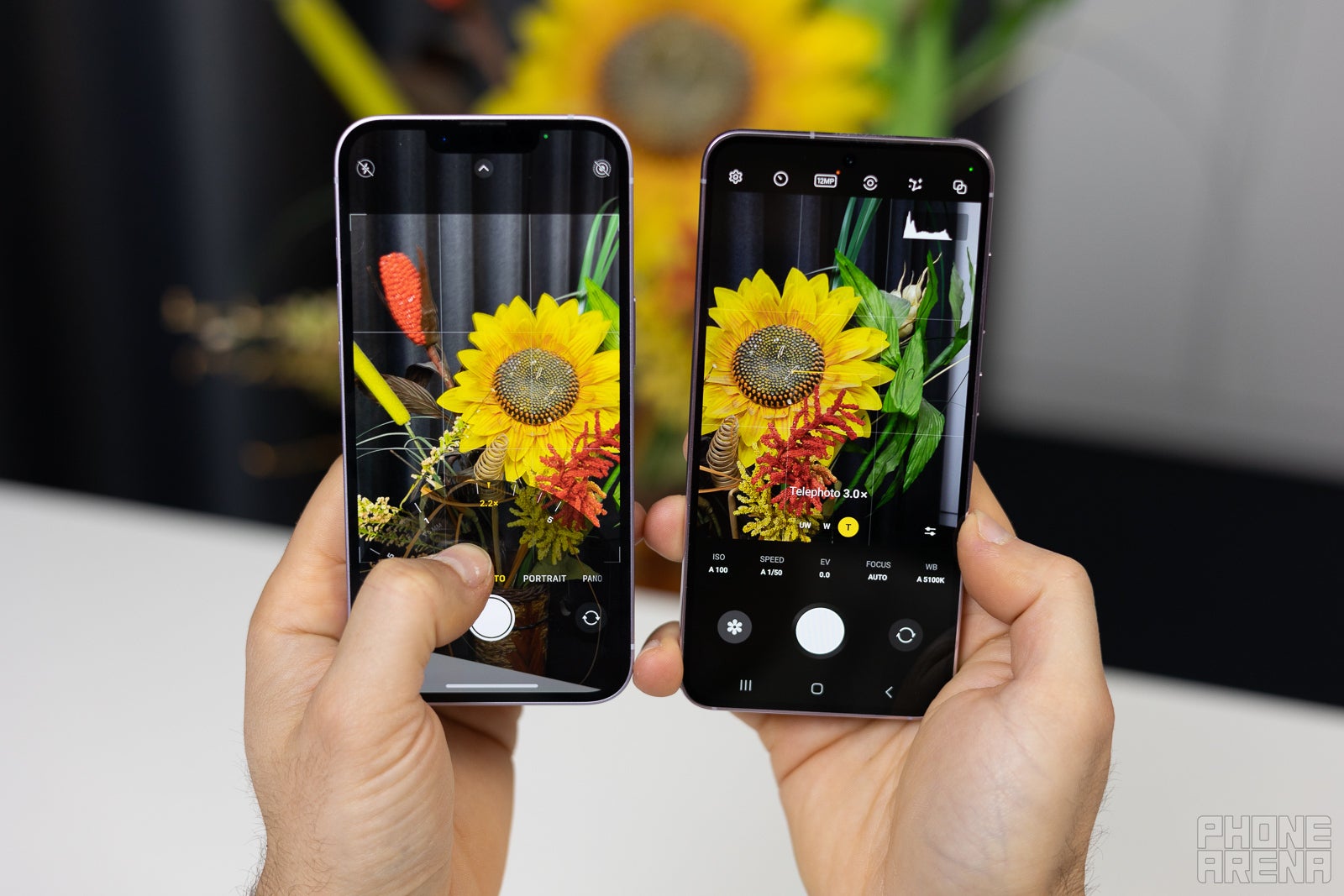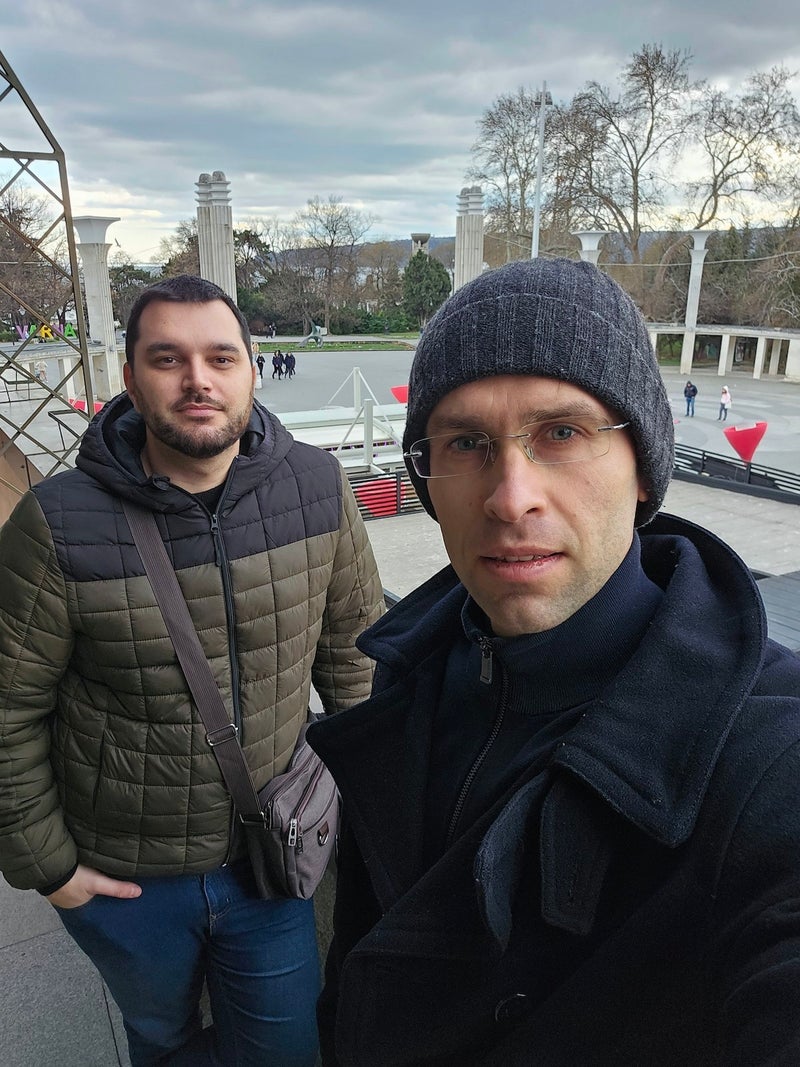Samsung Galaxy S23 vs Apple iPhone 14: more for your $700!
We may earn a commission if you make a purchase from the links on this page.

Intro
Samsung's Galaxy S23 series is now yesteryear's news, as the imminent arrival of the new Galaxy S24 phones looks very likely. But the S23 isn't gone forever — Samsung still sells it officially, $100 off and still kicking!
The base model — the Galaxy S23 — is the most affordable and most compact of the trio. It cuts some corners to keep its size and price, but the important things are left intact — triple cameras, upgraded 12 MP selfie camera, 120 Hz AMOLED screen, and a relatively large battery. $700 for the 128 GB model, $760 for the 256 GB upgrade — we recommend the latter, because it ups the storage chip to UFS 4.
Guess what — Apple's iPhone 14 is also now the "older model" and has also dropped to $700 entry price. Apple's "budget" model from the 14 family shoots low, with a 60 Hz screen (yes, it was released in 2022), a dual camera (wide, ultra-wide), and the processor from the iPhone 13 series.
So, if you are a savvy shopper looking at these discounted devices — which is the better deal? The iPhone 14 or Galaxy S23? We compare them fully below!
Galaxy S23 vs iPhone 14 as per the leaks:
- Similar in size and weight
- iPhone Face ID vs Galaxy in-display fingerprint scanner
- Galaxy has multi-tasking and DeX on board
- Galaxy has triple camera with optical zoom, iPhone 14 is dual cam
- Galaxy has 120 Hz screen, iPhone 14 sticks to 60 Hz
- Galaxy has USB Type-C port, iPhone 14 sticks with Lightning
- Android vs iOS
Table of Contents:
Design and Display Quality
OLED but one of them has an extra AM

iPhone 14 vs Galaxy S23 (Image Credit - PhoneArena)
Samsung's AMOLED screens have been excellent for years now and the manufacturer barely needed to do anything to upgrade it for the Galaxy S23. But hey, Samsung did sneak in a max brightness buff so it now hits 1,750 nits peak brightness (up from 1,500). This beats the 1,200 of the iPhone 14, but in general — both of these devices are perfectly viewable under direct sunlight, and support HDR video.
Apple's iPhone 14 line has OLED screens as well — funny enough, a huge portion of them are made by Samsung (and some are manufactured by LG). So, it's the same build quality, but tuned to Apple's requirements. Where Samsung gives you a couple of color calibrations to choose whether you want boosted colors or tamed and realistic ones, Apple goes for only one standard calibration.
In general, both screens look fantastic, it's just that they reflect the brand philosophies behind them. Samsung lets you tweak a bit, Apple has it set up "the way it should be".

Galaxy S23 vs iPhone 14 (Image Credit - PhoneArena)
Other features, like automatically tuning the white balance of the screen are present on both Galaxies and iPhones. So, these screens are usually a pleasure — and not a strain — to view.
Samsung seems to be happy with the 6.1-inch diagonal and a 19.5:9 aspect ratio, so the Galaxy S23 retains those specs. Diagonal and aspect ratio are the same on the iPhone 14. When it comes to resolution and sharpness, Apple's screen has 460 pixels per inch, while the Galaxy's comes to 425 but really, that's not a difference to be bothered about.

Both are easy to handle (Image Credit - PhoneArena)
As for design, we do get a slight change with the Galaxy, a bit of a facelift if you will — a fully flat back and 3 protruding metal rings around the camera lenses. On the front, of course, the Galaxy will only have a single hole for the selfie camera while the iPhone 14 still has that signature notch.
That is because Apple uses Face ID for biometric unlocks and payment authentication and still hasn't incorporated any sort of under-screen sensors. Face ID has been improved over the past 4 years and is now quick, accurate, and you barely even think about it. Samsung still prefers to stick to under-screen fingerprint scanners for that — ultrasonic technology, which has also improved in speed. The latter's benefit is that it can accurately read a scan even if your finger happens to be smudged up, a bit too wet, or a bit too dry.

Galaxy S23 vs iPhone 14, Infinity O vs Notch (Image Credit - PhoneArena
The iPhone 14 still has MagSafe — that ring of magnets on its back that allow it to utilize various smart accessories like stands and magnetic powerbanks. These definitely improve the overall experience and it's sometimes hard to go back to a phone that can't just stick to a wireless charger.
On the other hand, the Galaxy S23 has a USB Type-C port for charging and data transfer, which makes it infinitely easier to find a spare cable when you are in a pinch. And, of course the phone also has wireless charging, just no magnetic sticking to stuff.
Performance and Software

When Qualcomm announced the Snapdragon 8 Gen 2 it came with big numbers — 35% faster performance, 40% better power-efficiency. And the Galaxy S23 comes with a special edition Snapdragon 8 Gen 2 that has been overclocked. So, we get some extra juice out of it!
The iPhone 14 was kind of cheated out of an upgrade — instead of getting the brand-new A16 Bionic, it got a 2021 Apple A15 Bionic with an added extra GPU core. But... A15 is already pretty overkill. It can be argued that iOS 16 barely makes use of all the power that it has on tap.
Samsung also touted an increase in the size of the cooling vapor chamber, providing prolonged endurance and less throttling. On the 3DMark Extreme Stress Test, we can see that the Galaxy is neck in neck with the iPhone. The Apple A chips finally have a competitor.
Now, as for software, it has come to the point where comparing Apple to Samsung is like comparing apples to oranges. The iPhones are still much more single-task oriented phones that are very reliable and have a robust ecosystem that Apple fans enjoy day in and day out. The Galaxy's One UI interface is more flexible, as it basically invites you to utilize its split-screen multitasking capabilities and vast customization options.
An argument can be made that users who go for the smallest, 6.1-inch Galaxy S23 probably do not get it for multitasking. However, One UI has the tendency to constantly give you access to floating windows, so you can answer that text or check that email without leaving whatever you were doing on the phone. It's definitely a different type of workflow — one that is also hard to leave behind if you consider switching away from the Galaxy.
Samsung also has the DeX interface, which is admittedly super niche. However, if you connect the phone to an external monitor, mouse, and keyboard — you get to work in a desktop-like UI powered straight from your phone. Or, you can connect it to an old laptop and let the Galaxy "take over" its screen and peripherals. You'd be surprised to see how an old Windows machine can be revived when a Snapdragon 8 is at the wheel.
Samsung has pledged 4 years of major Android updates for its Galaxy S23 series. It launched with Android 13 (One UI 5.1) and will end up with Android 17 (One UI 9) when it taps out. History teaches us that the iPhone 14 will probably go a bit longer than that — up to 5, maybe even up to 6 years. It launched with iOS 16 and we would absolutely not be surprised if we see it get iOS 21 in 2027. But, in general, considering that the iPhone 14 had almost half a year head start, both of these phones will have a similar lifespan.
Camera
Someone here needs an upgrade

Galaxy S23 vs iPhone 14 cameras (Image credit - PhoneArena)
The S23 didn't change much about the Galaxy S22's camera module. We have the very same combo of cameras on its back — 50 MP main, 12 MP ultra-wide, 10 MP telephoto. There is, thankfully, an upgraded selfie camera on the front, now 12 MP.
The improvements here generally come from the new Snapdragon chip, which now does a lot more segmenting when taking a photo, allowing the phone to post-process a picture with better "knowledge" of the subject and background.
The iPhone 14 on the other hand needed a bit more oomph than what Apple gave it. The Pro models got the new 48 MP sensor and the upgraded ultra-wide camera, the base ones got a slightly bigger — but still 12 MP — main sensor and they inherited the ultra-wide camera from the iPhone 13 Pro.
Wide
Zoom
Wow! The iPhone 14... is not bad, and that's all we can say about these samples. The Galaxy S23 produces shots that are slightly colder — a matter of preference there — but the details and the balance of dynamics is fantastic. The iPhone shots looks a bit oversharpened, a bit jagged. And when it comes to zooming in — the Galaxy S23's zoom camera absolutely takes it home.
On the Portrait Mode — we are torn. The iPhone 14 produces a slightly more convincing bokeh and thanks to the fact that most of the environment is blurred — we don't get to see the oversharpening and jagged lines. Also, the iPhone 14 is a bit more honest with facial features, whereas the Galaxy — as usual — smoothes out wrinkles and imperfections.
On the other hand, the Galaxy has a telephoto lens for better, less warped portraits with a flatter look. The iPhone just... doesn't have that unless you upgrade to a Pro.
As for selfies — the color temperature is different from both phones, OK. But details and facial features are fantastic on both.

Audio Quality and Haptics

Galaxy S23 and iPhone 14 speakers (Image credit - PhoneArena)
The Galaxy S23 line got a bit of an upgrade to its speakers, it seems. Even the base Galaxy S23 sounds cleaner and richer. It may be a bit tinny, due to the physical constraints of the small phone, but in general we were happy with the sound of its stereos peakers. The iPhone 14 has a bit more of a mid scoop going on, and more audible bass plus more air in the presence. We'd say both handsets sound good, though the iPhone may be a bit harsh depending on the music style of choice.
As for haptics — the flagship Galaxy phones have been clicking and clacking with very pleasant and reassuring feedback over the last few years. But so have iPhones with their amazing Taptic engine — the one that makes the Apple Watch vibration feel so great.
Battery Life and Charging
One has impressive standby, the other may have great sustained performance.
So, the Galaxy S23 has a slightly larger battery — 3,900 mAh versus the 3,700 mAh in the Galaxy S22. Add to this the enhanced energy-efficiency of the Snapdragon 8 Gen 2 and we are already have better longevity on a single charge.
Typically, iPhones are amazing at holding charge while in standby and they do very well with common tasks like browsing and video-watching. Usually, when it comes to gaming tests, Android phones do better, while Apple's A15 chip drains the comparably small battery of the iPhone faster.
Specs Comparison
When it comes to cold, hard specs - here's what these phones have to offer:
| Specs | Galaxy S23 | iPhone 14 |
|---|---|---|
| Dimensions | 5.76 x 2.79 x 0.30 inches (146.3 x 70.9 x 7.6mm) | 5.78 x 2.81 x 0.31 inches (146.7 x 71.5 x 7.80 mm) |
| Weight | 5.93 oz (168.0 g) | 6.07 oz (172.0 g) |
| Screen | 6.1 inch, AMOLED, 120 Hz, 1080 x 2340 | 6.1 inch, OLED, 60 Hz, 1170 x 2532 |
| Processor | Qualcomm Snapdragon 8 Gen 2 (4 nm), 3.36 GHz, octa-core | Apple A15 Bionic (5 nm), 3.1 GHz, hexa-core, with pentacore GPU |
| RAM | 8 GB LPDDR5X (on 256 GB model) | 6 GB LPDDR5 |
| Rear Cameras | 50 MP wide 12 MP ultra-wide 10 MP telephoto | 12 MP wide camera: 26mm, f/1.5 12 MP ultra-wide camera: 0.5X, or 13mm, f/1.8 |
| Front Camera | 12 MP with autofocus | 12 MP with autofocus |
| Battery Size | 3,900 mAh | 3,279 mAh |
| Charging Speeds | 25 W wired 10 W wireless | 20 W wired 15 W wireless MagSafe 7.5 W wireless Qi |
| Price | $699 | $699 |
It's worth noting that if you want UFS 4.0 and LPDDR5X on your Galaxy S23, you need to buy the 256 GB version. The base 128 GB variant has UFS 3.1, which is slower than the new storage, and LPDDR5. The iPhone uses NVMe storage, which is a bit hard to compare to UFS 4.0, but in general — it is slower. In real life, though? No worries, both of these phones are solid.
Summary and Final Verdict
We've got two phones that are powerful and reliable, yes. Taken at face value, we'd say the Galaxy is definitely the better deal here — you have a 120 Hz screen (which should be standard in 2022-2023) and you have a triple camera module with a telephoto lens. The iPhone 14, in comparison, feels basic when it lacks those specs, yet costs the same price.
However, this comparison is about a lot more than Phone A vs Phone B. Both of these companies have become tech giants that offer smartwatches, headphones, tablets, and laptops — all of which work in tandem.
Like the always-mentioned Apple ecosystem — with all of its devices seamlessly talking to one another. If you are in there, with an Apple Watch, AirPods, AirTags, and a MacBook, of course you will probably lean more towards the iPhone. At the same time, you may feel a bit cheated, as the iPhone 14 seems so... uninspired.
Samsung has also gained a lot of ground and integrated into a lot of different areas. The SmartThings hub can connect to your Samsung home appliances, the Galaxy SmartTags, and the company also offers the excellent Galaxy Watch wearables and Galaxy Buds earphones. The base Galaxy S23 will connect to all of that and look good doing it. And
So, don't let the green bubbles bully you, the Galaxies have a lot going for them!
So, don't let the green bubbles bully you, the Galaxies have a lot going for them!






























![iPhone users on AT&T left without service after massive outage [UPDATED]](https://m-cdn.phonearena.com/images/article/161893-wide-two_350/iPhone-users-on-AT-T-left-without-service-after-massive-outage-UPDATED.jpg)














Things that are NOT allowed: